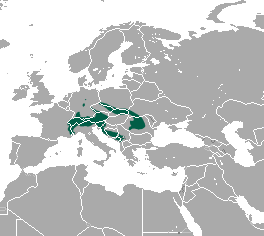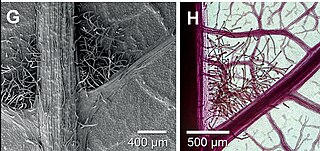Related Research Articles

Shrews are small mole-like mammals classified in the order Eulipotyphla. True shrews are not to be confused with treeshrews, otter shrews, elephant shrews, West Indies shrews, or marsupial shrews, which belong to different families or orders.

The red-toothed shrews of the subfamily Soricinae are one of three living subfamilies of shrews, along with Crocidurinae and Myosoricinae. In addition, the family contains the extinct subfamilies Limnoecinae, Crocidosoricinae, Allosoricinae and Heterosoricinae. These species are typically found in North America, northern South America, Europe and northern Asia. The enamel of the tips of their teeth is reddish due to iron pigment. The iron deposits serve to harden the enamel and are concentrated in those parts of the teeth most subject to wear. Members of the genera Chimarrogale, Nectogale, Neomys (Nectogalini) and some members of Sorex (Soricini) are known as water shrews, due to having a semi-aquatic lifestyle.

The Arctic shrew, also known as the blackback shrew or saddlebacked shrew, is a medium-sized shrew found in Canada and the northern United States. Separate species status has been proposed for the maritime shrew which is found in New Brunswick and Nova Scotia and had been considered to be a subspecies of the Arctic shrew. The tundra shrew was formerly considered to be a subspecies of the Arctic shrew.

The marsh shrew, also known as the Pacific water shrew, Bendire's water shrew, Bendire's shrew and Jesus shrew is the largest North American member of the genus Sorex. Primarily covered in dark-brown fur, it is found near aquatic habitats along the Pacific coast from southern British Columbia to northern California. With air trapped in its fur for buoyancy, marsh shrews can run for three to five seconds on top of the water. It measures about 16 cm (6.3 in) in length, including a 7-centimetre (2.8 in)-long tail, and weighs an average of 14.5–16 g (0.51–0.56 oz). The marsh shrew's diet consists mainly of invertebrates, which it hunts on land and in the water. They are rare; their populations are thought to be in decline, and they are considered endangered in parts of their range.

The genus Sorex includes many of the common shrews of Eurasia and North America, and contains at least 142 known species and subspecies. Members of this genus, known as long-tailed shrews, are the only members of the tribe Soricini of the subfamily Soricinae. They have 32 teeth.

The common shrew, also known as the Eurasian shrew, is the most common shrew, and one of the most common mammals, throughout Northern Europe, including Great Britain, but excluding Ireland. It is 55 to 82 millimetres long and weighs 5 to 12 grams, and has velvety dark brown fur with a pale underside. It is one of the rare venomous mammals. Juvenile shrews have lighter fur until their first moult. The common shrew has small eyes, a pointed, mobile snout and red-tipped teeth. It has a life span of approximately 14 months.

The alpine shrew is a species of mammal in the family Soricidae. It is found in the alpine meadows and coniferous forests of central and southern European mountain ranges.

The Iberian shrew or Lagranja shrew is a species of mammal in the family Soricidae. It is found in Portugal and Spain.

The Inyo shrew is a species of shrew found in the western United States. It is light gray and white in color, with a narrow skull and small body size, very similar in appearance to the related dwarf shrew, but paler and not as large. It can be found in many different habitats, from rocky, mountainous regions to wetlands and riparian areas. Not much is known about its behavioral and reproductive habits. While barely studied, their population is believed to be stable and not under any threat.

Trowbridge's shrew is a species of mammal in the family Soricidae. It is found in southern British Columbia in Canada and in Washington, Oregon, and California in the United States.

Acarodomatia, are tussocks of hairs or nonglandular trichomes located in pits situated in major leaf vein axes of many plant species, occupied and caused by predatory and mycophagous mites.
Demodecidae is a family of parasitic and commensal mites, living on various species of mammals. Each species of mite is usually only found on a single mammal species, whereas a mammal species can have several different species of demodecid mites living on it. Many species of mites are restricted to very limited areas of their body, e.g. the Meibomian glands, the ear canal, the tongue etc. The family was formerly named Demodicidae.

The Valais shrew is a species of mammal in the family Soricidae.

Listrophorus is a genus of parasitic mites in the family Listrophoridae. North American species with their hosts include:
Demodex bovis, also known as the cattle follicle mite, usually causes demodicosis, or demodectic mange, in cattle. This disease is common in tropical areas and is not usually found in temperate environments. Demodicosis is characterized by the formation of papules and nodules over the cattle's skin. These lesions most commonly occur on the neck, shoulders, and armpit of cattle; however, sometimes they also appear on the udder. This condition is often found in cattle with increased stress from pregnancy or lactation. Natural and acquired immunity can cause a decrease in the number of mites infesting a cow, as well as decreasing the severity of a cow's symptoms.
Sorex araneus grantii is a subspecies of the shrew Sorex araneus, found only on the Scottish island of Islay. It was previously considered a separate species, Sorex grantii. It is distinguished from mainland shrews by its very grey flanks and different dentition.

The long-tailed shrew or rock shrew is a small shrew found in Atlantic Canada and the Northeastern United States.
Syringophilopsis is a genus of mites that parasitize the feathers of passeriform birds.
Demodex foveolator is a hair follicle mite found in epidermal pits of the lesser white-toothed shrew, Crocidura suaveolens.
References
- ↑ Bukva, V. (1982). "Soricidex dimorphus g.n., sp. n. (Acari: Demodicidae) from the common shrew, Sorex araneus." Folia Parasitologica 29: 343-349.
- ↑ Bukva, V. (February 1993). "Sexual dimorphism in the hair follicle mites (Acari: Demodecidae): scanning electron microscopy of Soricidex dimorphus". ResearchGate. Folia Parasitologica 40(1):71-9. Retrieved 2 February 2024.